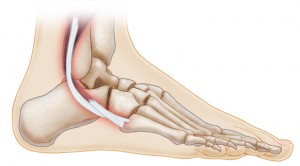Peroneal tendonitis is an ankle injury that usually occurs after a lateral ankle sprain, or after overuse of the peroneal tendons—the tendons that run over the lower end of the fibula that protrudes on the lateral (outer) side of the ankle.
The term tendonitis is typically used to describe tendon inflammation, which is characterized by warmth, redness, swelling, pain, and loss of function. However, in peroneal tendonitis, there is swelling of the tendon; patients may have pain and swelling, but usually there is no warmth, redness, or loss of function.
Certain repetitive activities, such as running, over long periods can cause this type of tendonitis, although it can also occur after attempting a new exercise or after increasing one’s level of activity.
Where Are the Peroneal Tendons?
You have two peroneal tendons: the peroneus brevis and the peroneus longus. One or both of these tendons may be affected by peroneal tendonitis.
The peroneus brevis is the shorter of the two tendons. It starts lower in the leg, runs down around the back of the fibula, and attaches to the fifth metatarsal on the outer side of the foot.
The peroneus longus starts higher on the leg and runs all the way down, underneath the foot. It then attaches to the first metatarsal (the big toe) on the inner side of the foot. These tendons enable you to turn your foot outward.

Signs and Symptoms of Peroneal Tendonitis
Pain behind and below the ankle on the lateral (outer) side is the most common symptom of peroneal tendonitis. The pain occurs along one or both of the tendons and may radiate to the foot. Swelling and stiffness may be present.
As with other overuse injuries, pain is often worse during activity but gets better with rest. You may feel pain when pressing on the peroneal tendons over the lateral ankle. People with peroneal tendonitis are usually able to walk, but may walk with a limp because of the pain.
How Did I Develop Peroneal Tendonitis?
Peroneal tendonitis is caused by a lateral ankle sprain or by overuse that occurs when the peroneal tendons are overworked through repetitive or excessive use of the ankle.
These tendons are more likely to work harder and develop tendonosis in the following circumstances:
- You had improper training or rapid increases in training
- You wear improper shoes for certain athletic activity
- You have a hindfoot varus posture, in which the heel is slightly turned inward
One common activity that can stress the ankle is marathon running.
How is Peroneal Tendonitis Diagnosed?
A diagnosis of personal tendonitis requires a physical examination by your primary healthcare provider or a podiatrist. Your doctor will ask you to provide a history of your ankle and foot symptoms.
It is important to describe the types of activities and sports you participate in. Your doctor may ask whether you have tried a new exercise or have markedly increased your activity level.
To begin the examination, your doctor will palpate the peroneal tendons to determine the exact location of the pain. The pain of peroneal tendonitis is generally felt slightly behind the bony protuberance of the lower fibula.
The pain may be reproduced with inversion, or turning the ankle inward. You may have weakness in trying to turn the ankle out to the side (eversion). Your doctor will also look for varus posturing of the heel.
Often the diagnosis can be made on the basis of the patient’s medical history. X-rays will be taken in order to rule out jones fracture or avulsion fracture of the fifth metatarsal.
Your doctor may perform an ultrasound examination, which can show any abnormal appearance of the tendons, such as enlargement and thickening—or in rare cases, a tear. MRI can also be used to determine whether a tendon has been torn.
How is Peroneal Tendonitis Treated?
Patients with peroneal tendonitis are treated similarly to those with other overuse injuries, with rest for several weeks and follow-up. Conservative treatment of peroneal tendonitis may include:
Rest. You will be advised to avoid pain-inducing activities and limit how much you walk until the pain decreases. After the pain subsides, you can resume training at a modest pace.
Ice. You can apply ice to the painful area for 10 to 20 minutes every hour until symptoms abate.
Pain medication. Your doctor may recommend taking a non-steroidal anti-inflammatory medication for the pain.
Ankle brace or orthotic. If you have significant pain, your doctor may prescribe a CAM Walker boot. An ankle brace is another option if you have little or no tenderness with walking. If you have hindfoot varus, your treatment may include an orthotic that tilts the ankle to the opposite side.
Activity modification. Changing your training and footwear and alternating activities each day can help.
Tendon rehabilitation. Your doctor may also recommend physical therapy or stretching exercises you can do at home to strengthen the tendons.
If the pain recurs, you will need to re-try the conservative treatment listed above. Conservative treatment should continue for up to a year before considering corticosteroid therapy or surgery.
If you have a tear, treatment may involve repair or resection of the tendon, depending on the extent of the damage.
Recovery From Peroneal Tendonitis: What to Expect
In most cases, people with peroneal tendonitis heal well without complications, although complete recovery may take quite a long time. The tendon must be allowed to heal before activity is resumed.
Those who return to activity too soon risk further injuring the tendon, or even tearing it, which may require surgery. A tear indicates chronic thickening of the tendon, which may not respond well to conservative therapy.
Recovery after surgery for a damaged peroneal tendon can take up to a year or longer.
What are the Complications of Peroneal Tendonitis?
The most common complication of peroneal tendonitis is tearing of the tendon. Weakness of the tendons can lead to an ankle sprain. Complications associated with peroneal tendon surgery include infection, nerve damage, and ankle instability.




